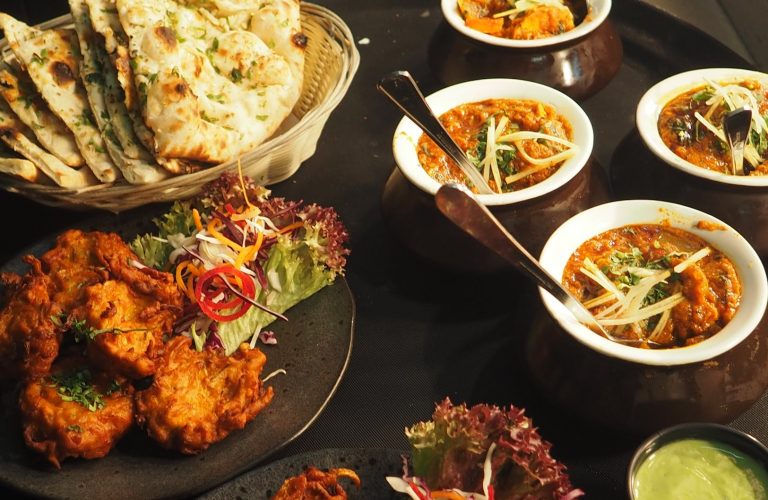The diet of the Middle East and the Mediterranean is one of the healthiest in the world. Middle Eastern countries, (including those on the Mediterranean) have many things in common. These countries have been inhabited since ancient times, share elements of a Greco-Roman culture; share a dry climate; harvest the beauty of the seas; grow many foods in common. All have some version of the mezze.
Mezze (Mezzeh) A typical middle eastern meal starts with Mezze. This can be an elaborate spread of forty or fifty hors d’oeuvres, little bits of tasty treats to please the palate. The origin of the word mezze is unclear. It may be derived from the Persian “maza” meaning “taste, relish,” or from the Arabic “mazmiz” which means to nibble at food. It may come from the Assyrian word ‘mez’ meaning table, and it would take many small tables to serve mezze. However we view the origin, it represents the pleasure of savoring little pieces of food. The mezze tradition extends from Turkey into the Balkans, including Greece, and spreads to Middle east countries. Almost anything that is small and tasty qualifies as a mezze dish. A basic mezze table can be as simple as a basket of warm pita, a plate of fresh herbs, another plate of feta cheese or yogurt cheese, a dish of olives, some dips and salads and a pitcher of iced water. You can also find hummus, a dip made of ground chickpeas, fattoush, a salad of green vegetables mixed with pieces of pita bread, grilled eggplant and zucchini. Other popular dishes are tabouli, a bulgur wheat salad, and kibbeh, made from freshly ground lamb and/or beef – a dish which can be eaten baked, fried or even raw. Mezze can include miniature versions of main dishes. To give a mezze table the status of a mezze feast, simply increase the number and variety of dishes, including perhaps a few heartier choices like small kebabs or one or two bean dishes that can be served cold.
Glossary of Middle Eastern Terms:
Za’tar (or zatar) is popular from Greece to Israel. It is a mixture of spices and herbs such as dried powdered hyssop, sumac, sesame seeds, oil, salt. Most za’tar is consumed as a condiment, made by grinding hyssop leaves to a coarse, aromatic, brownish green powder then mixing the powder with olive oil, toasted sesame seeds, sumac, chickpeas, and wheat.
Geographically, Israel is a hyssop center. The plant is native to the hill regions of the ancient Land of Israel and parts of Lebanon and southern Syria. Za’tar is not only eaten with bread but also used to season meat, as a topping on spreads and even sprinkled on salads.
Sumac – comes from the berries of a wild bush that grows wild in all Mediterranean areas, especially in Sicily and southern Italy, and parts of the Middle East, Dark purple-red berries are sold dried or ground throughout the Middle East and Italy, and have a fruity, astringent taste. In the States it can be found in middle eastern stores. It’s fleshy petals and small berries are dried and reduced to purple powder, which has an acid taste and is very popular in Middle Eastern cookery. Mixed with water it can be used in the same way as lemon juice.
Falafel – spicy balls that can be made with chickpeas or dried white broad beans or both. Delicious wrapped in flat bread as a sandwich, with lashings of garlic or tahini sauce.
Hummos – pureed chickpeas, sesame oil and lemon juice. Widely available around the world now, but not like the real thing! Also try the version with added meat.
Tabouleh – Parsley, tomato, lemon juice, mint, cracked wheat and olive oil salad.
Moutabal (Baba Ghanouj) – grilled aubergines (eggplants) with sesame oil and lemon juice.
Kalaj – halloumi cheese on pastry, baked in the oven.
Foul moudamas – boiled broad beans with lemon juice, olive oil and garlic.
Sambousak – pastry filled with mince mean and pine kernels (or cheese).
Lahma bi ageen – sumac and pomegranate juice are still used as a souring agent. Mixed with water, ground sumac was believed to aid digestion and prevent diarrhea, but now it is commonly used as a condiment in Lebanon, Syria and Iran. It’s delicious and commonly used on fish, kebabs and sprinkled over flat bread.
Chicken or lamb shawarma – these sandwiches, often bought on the street, are delicious. Often served with pickles, tomato, garlic or tahini sauce and even chips inside.
Kaek – a pizza like bread with meat on it.
Farrouge Moussahab – boneless chicken, charcoal grilled and served with garlic sauce.
Tawayeh – cubes of tender lamb cooked with onion, garlic, hot peppers and tomato.
Juices – freshly squeezed orange, apple, carrot and pomegranate are not only really good for your health, but delicious and readily available on the street. Baklava – the classic sticky dessert made with eight layers of special pastry dough, using clarified butter, syrup and seven layers of nuts.


Thank you, I have just been looking for info approximately this topic for a while and yours is the best I’ve discovered till now. But, what in regards to the bottom line? Are you certain in regards to the supply?